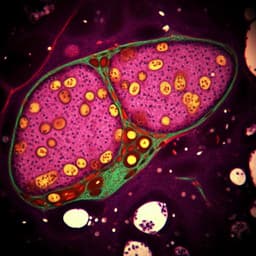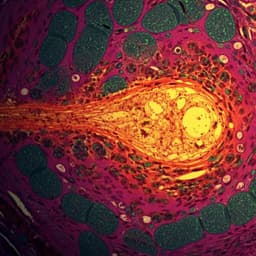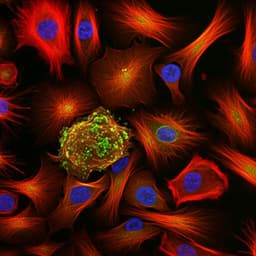
Medicine and Health
Single-cell analysis of chromatin and expression reveals age- and sex-associated alterations in the human heart
D. F. Read, G. T. Booth, et al.
Explore the groundbreaking research by David F. Read and colleagues, which unveils age- and sex-related changes in the human heart at a single-cell level. This study reveals important epigenetic signatures and metabolic alterations, providing a fresh perspective on cardiac aging through extensive cellular analysis.
~3 min • Beginner • English
Introduction
The study investigates how biological sex and age shape transcriptional and epigenetic programs within specific cell types of the healthy human heart. While sex- and age-associated differences in cardiac physiology (e.g., cardiomyocyte loss rates, vascular elasticity) and aging phenotypes (e.g., hypertrophy, stiffness, inflammation) are known, the molecular hallmarks and cell-type-resolved mechanisms remain uncertain. Single-cell methods have profiled cardiac cellular diversity and regulatory programs, but a comprehensive characterization of age- and sex-dependent molecular variation across individuals at single-cell resolution has been lacking. The purpose here is to generate matched single-nucleus RNA-seq and ATAC-seq data across donors and integrate them with external datasets to dissect cell-type-resolved transcriptional and chromatin accessibility changes associated with sex and age, identify candidate regulatory factors, and build predictive models linking regulatory DNA to gene expression.
Literature Review
Prior work has shown sex and age strongly influence cardiac structure and function, with single-cell studies cataloging human cardiac cell types and regulatory programs and atlases in model organisms dissecting aging and disease processes. Previous single-cell analyses in humans identified cell-type diversity and regulatory landscapes, while studies in mice revealed aging-related transcriptional changes. Recent adult human heart snATAC-seq datasets enable interrogation of regulatory programs. Developmental studies highlight dynamic roles of transcription factors during cardiac development. Quantitative models have linked DNA sequence and chromatin features to gene expression, with evidence that distal enhancers carry crucial cell-state information. However, generalization of such models across diverse in vivo human cardiac cell types and systematic, cross-cohort analyses of sex- and age-related variation have been limited.
Methodology
- Cohort and sampling: 15 samples from 9 human donors (mostly apex or left ventricular wall) were processed to minimize warm ischemic time. Each sample represented a specific anatomical site per donor.
- snRNA-seq: Three-level sci-RNA-seq with modified nuclei isolation (additional RNase inhibitors, mechanical dissociation, 5% glutaraldehyde fixation) and FACS sorting after ligation to reduce background RNA. One sample failed; 14 samples from 8 donors yielded 89,404 nuclei post-filtering. Data were processed via Nextflow pipelines (bb-dimux, bb-sci). Cells were filtered by UMI counts and mitochondrial RNA, doublets removed, and integrated with Monocle 3 using mutual nearest neighbor alignment and UMAP for visualization.
- snATAC-seq: Three-level sci-ATAC-seq produced 11,738 high-quality profiles across 15 samples from 9 donors. ATAC data were co-embedded with RNA, and cell-type labels were transferred from RNA to ATAC using a k-nearest neighbors classifier.
- Cell-type annotation and QC: Marker genes and TF motif enrichments validated expected cell types (e.g., cardiomyocytes, fibroblasts, endothelial cells; rarer adipocytes, neurons, mast cells, B cells). TF motif enrichments matched known regulators (MEF2 in cardiomyocytes, SPI1 in macrophages, CEBPB in fibroblasts).
- Differential expression (DE): For newly generated data, generalized linear mixed models (negative binomial) in Monocle 3 tested associations with sex and age, with donor as random effect and anatomical site, age, sex, and UMI as fixed covariates; Benjamini–Hochberg FDR control (e.g., FDR 0.1).
- Meta-analysis: Combined six snRNA-seq studies (n=73 unique donors) and used NEBULA (negative binomial mixed model) with donor as random effect and data source, age, sex, UMI, and anatomical site as fixed effects; BH FDR control.
- TF motif accessibility analyses: Motif presence in peaks detected using MOODS/FIMO at defined p-value cutoffs. Motif count-by-cell matrices derived from peak-by-cell accessibility matrices. For covariate-dependent motif changes (age/sex) and cell-type enrichment, GLMMs (negative binomial) were fit using the limd package with donor as random effect and anatomical site, age, and sex as fixed effects; BH correction.
- Cell-type proportion modeling: Beta-binomial mixed models (lme4) tested associations of proportions with age and sex, controlling for donor (random), anatomical site, and data source (in meta-analysis). Proportions were adjusted by regressing out covariates for visualization.
- Adult–fetal comparisons: Compared TF motif enrichments in accessible chromatin between adult cell types (this study) and matched fetal cell types from a public resource, focusing on motifs significantly enriched in either context (FDR 0.1).
- Gene expression prediction: For each cell type, pseudo-bulk RNA (log2 TPM) per gene was predicted with elastic net linear models using binary TF motif features from promoter-only or promoter+distal accessible sequences. Chromosome-split train/validation/test (≈80/10/10). Promoter window hyperparameters tuned; distal sites linked via co-accessibility cutoffs and constrained by maximum linked sites and window sizes. Final models trained with selected hyperparameters evaluated by R² on held-out test genes.
Key Findings
- Data generation and annotation: 89,404 high-quality snRNA-seq nuclei (14 samples, 8 donors) and 11,738 snATAC-seq profiles (15 samples, 9 donors) were obtained. Co-embedding and kNN label transfer enabled robust annotation of ATAC profiles.
- Sex-associated transcriptional changes: Mixed-model DE revealed many sex-dependent genes, especially in abundant cell types. Male samples showed decreased oxidative phosphorylation transcripts in cardiomyocytes, vascular endothelial cells, and macrophages, and decreased cholesterol metabolism transcripts in macrophages. Decreases in TGFβ signaling were observed in male fibroblasts and macrophages, with increased EMT hallmarks in macrophages, vascular endothelial, and perivascular cells. TF analyses implicated HIF1A, MYC, and RORA signaling consistent with metabolic reprogramming.
- Age-associated transcriptional changes: Hundreds of age-associated DE genes across cell types. Aged fibroblasts, macrophages, endothelial cells, and cardiomyocytes showed increased TGFβ signaling hallmarks. Immune pathways increased with age, including inflammation in fibroblasts/macrophages and interferon responses in macrophages and endothelium.
- Chromatin motif changes: With age, IRF1 and IRF7 motifs were enriched in accessible peaks in multiple cell types, aligning with increased interferon responses. Conversely, a significant decrease in NFKB motif accessibility with age was detected.
- ATAC–RNA concordance: Some discrepancies were noted between motif accessibility changes and transcriptional signatures across cell types, as expected due to assay differences and sample size.
- Meta-analysis across studies (n=73 donors): DE signals concentrated in cardiomyocytes, but pathway-level sex and age associations were widespread. Sex differences in metabolic pathways and age-associated shifts in immune, lipid metabolism, and UV-response pathways were reproduced. Some findings (e.g., TGFβ signatures by sex) were not consistently replicated across datasets.
- Cell-type composition: A sex-associated difference in cardiomyocyte proportion was detected (p = 0.013). Neuronal proportions decreased with age (p < 0.05) after adjusting for covariates. Sex-associated gene differences in neurons and cardiomyocytes included genes linked to neural function and cardiomyocyte hypertrophy/arrhythmia (e.g., KCNJ3 higher in males; GADD45G higher in males; KDM6A higher in females).
- Developmental regulators: Adult–fetal motif enrichments were broadly correlated within matched cell types, but adult-specific neuronal motif enrichments for PROX1, ZBED1, and TBR1 contrasted with fetal-specific NOTO and RORA, suggesting stage-specific regulators. Signals implicating RFX family members were observed in macrophages and endothelial/perivascular cells; vascular regulators FOXP1/FOXF were enriched in vascular cell chromatin.
- Predictive modeling: For expression prediction, promoter-only models performed best with promoter windows around 2000 bp upstream and 1000 bp downstream of the TSS; adding distal motif features consistently improved performance across all cell types. Models using promoter+distal motifs explained roughly a quarter of variation in average cell-type-specific RNA expression, outperforming promoter-only baselines.
Discussion
The study demonstrates that sex and age are associated with extensive, cell-type-specific transcriptional and chromatin accessibility differences in the healthy human heart. Findings include sex-associated metabolic shifts (reduced oxidative phosphorylation in males) and age-associated immune activation (interferon and inflammatory pathways), with motif-level changes (IRF1/IRF7 enrichment, decreased NFKB accessibility) supporting transcriptional observations. While some assay-level discordances occurred between ATAC-seq and RNA-seq, these underscore the complementary nature of chromatin accessibility and transcription in capturing regulatory state. Integrating external datasets enabled broader inference: although gene-level DE was most evident in cardiomyocytes, pathway-level alterations spanned many cell types, and compositional changes (sex-associated cardiomyocyte proportion differences; age-associated neuron decline) were detected. Adult–fetal motif comparisons indicate largely conserved regulatory programs with outliers that likely mark developmental-stage-specific regulators, particularly in cardiac neurons. Finally, simple elastic-net models leveraging promoter and distal TF motif features quantify how distal accessible DNA improves prediction of cell-type-specific expression and highlight candidate TFs. Collectively, these results refine understanding of inter-individual, covariate-associated variation at single-cell resolution and provide a resource for hypothesis generation about regulatory mechanisms influencing cardiac biology.
Conclusion
This work delivers a matched single-nucleus RNA-seq and ATAC-seq resource for healthy human hearts across multiple donors and integrates it with external studies to dissect sex- and age-associated molecular variation at single-cell resolution. Key contributions include identification of sex-dependent metabolic programs, age-associated immune activation, compositional shifts across cell types, candidate developmental-stage-specific TFs from adult–fetal motif contrasts, and quantitative models linking promoter and distal regulatory motifs to gene expression. Future research should: (1) expand cohorts with richer clinical metadata (e.g., hormonal status, comorbidities) to model non-linear and interaction effects; (2) standardize sample handling and processing to reduce inter-study variability; (3) experimentally validate candidate stage-specific and cell-type-specific TFs (e.g., PROX1, TBR1, RFX family); (4) apply causal perturbations and longitudinal designs to address confounding in observational data; and (5) develop more expressive sequence-to-expression models (e.g., deep learning) that better leverage distal regulatory information and motif co-occurrence.
Limitations
- Cohort size and metadata: Newly generated data include 8 unique donors (14 samples), limiting power, with sparse metadata (e.g., menopausal status) restricting modeling of non-linear or interaction effects.
- Inter-study heterogeneity: Meta-analysis spans multiple datasets with differing sample handling, platforms, and processing, contributing to incomplete replication of some findings (e.g., sex-specific TGFβ signatures).
- Observational design: Potential confounding by unmeasured variables; causal relationships cannot be established.
- Assay discordance and noise: ATAC-seq and RNA-seq capture distinct regulatory layers, leading to expected mismatches; single-nucleus data can be noisy.
- Anatomical coverage: Samples largely from apex/left ventricular wall; limited spatial representation may affect generalizability.
- Validation: Developmental-stage-specific TF candidates identified by motif enrichment require functional validation; predictive models explain a minority of expression variance and rely on motif presence/absence abstractions.
Related Publications
Explore these studies to deepen your understanding of the subject.







